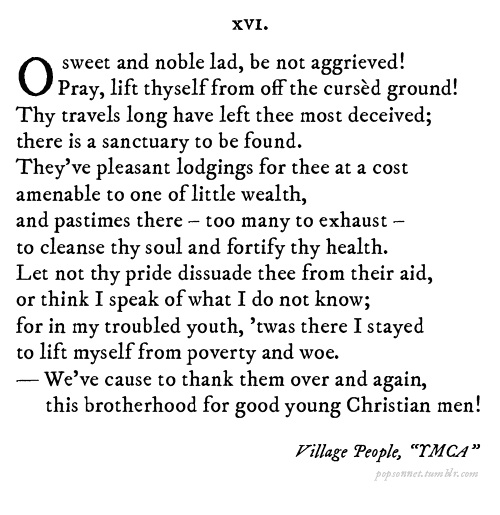Perhaps, before we consider what a masterpiece these witty poems are, we should consider the significance of the sonnet form itself.
A sonnet is an Italian form of poetry, that has been popular across Europe and has been used in many different contexts. There are various different types of sonnets, which have been modified through history for different purposes. The simple basics about sonnets are that they have fourteen lines (unless it's Sonnet 99 and 126 by Shakespeare) and they rhyme.
Originally, the sonnets had a problem/resolution form. Basically, there were two ideas that were linked. The first eight lines would have the first idea, and the remaining six lines stated the second idea. This change of ideas (called the volta) would be marked by a change of rhyme scheme. The first eight lines would have two sets of an a-b-b-a pattern. There were a number of ways the last six lines could go; commonly it would go c-d-e, c-d-e or c-d-c-c-d-c. There were other ways you could do it, but you would never end with a rhyming couplets- for some reason Italians didn't like it. These sonnets are called Italian or Petrarchian sonnets (after Petrarch, the guy that did not come up with them- that was Giacomo di Lentini).
However, English sonnets were different. The idea of the sonnet reached English shores a lot later and in the form of translation. They still had fourteen lines, they still rhymed, but were, perhaps, simpler in their execution. They generally consisted of an alternating rhyme scheme for the first twelve lines (a-b-a-b, c-d-c-d, e-f-e-f), completing on a rhyming couplet (Petrarch would be outraged!). Again, the English sonnet would have a thematic shift in the ninth line (the volta). Shakespeare, the saucy rascal, however, would usually leave the volta until the thirteen line, and the couplet would show the second idea or a summing up of the poem as a whole.
Shakespeare is perhaps the most famous sonneteer in the English language. He wrote 154 of them, as well as some making up the lines of his play. The scene where Romeo and Juliet meet consist of a perfectly balanced sonnet. Romeo holds the first quatrain (first four lines), Juliet speaks the next, complementing his religious language and metaphors with those of her own. The third quatrain is divided between them, and they each share a line of the finishing couplet (finishing with "purged").
How beautiful.
Henceforth, the sonnet form is used throughout literature until the present day (although it did fall out of fashion for a little bit before Wordsworth, à la Timberlake, decided I'm bringing sonnets back). Wilfred Owen used the form in, perhaps in a somewhat ironic fashion, his Anthem for Doomed Youth. The form is often reserved for themes of love, but this time it is used to describe the loss of thousands of young men during the fighting of World War I. It could symbolise the love he had for his fellow comrades, but the ironic reading fits in with the use of the celebratory and patriotic word 'anthem' in the poem's title.
Now, the time-honoured tradition of sonnets is being celebrated by this wonderful, wonderful person who invented the pop sonnet. It's purely Shakespearean in style (alternative rhyme, volta towards the end in the rhyming couplet, iambic pentameter), and they are so perfect they could almost be genuine. There are currently thirty two of them, but new ones are released each Thursday. Go check them out.

